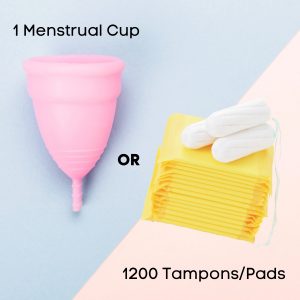As we aim to provide period dignity to women around the world, we should also be encouraging each woman’s responsibility towards environmental sustainability. Women have come a long way through history negotiating the rough terrains of period management. It’s time we paid attention to the ecological cost of our period management choices.

Back in time
The first ever historical mention of a sanitary pad, is in an amusing tale involving a 4th century Hellenic mathematician known as Hypatia of Alexandria. She is supposed to have thrown her menstrual rag at an admirer to discourage him. Well, if the tale is true she was indeed an exception. Given the largely domestic role of women throughout history, period management was centred around “secrecy” rather than “protection”. Women literally just stuffed anything absorbent inside their underwear – cotton, rags, hay, sheep’s wool, rabbit fur – basically everyday materials they could find around their homes that they didn’t have to pay for. Naturally, these practices only held women back from public life even more.
The invention of sanitary pads
Sanitary pads as we know them today – cotton wrapped in linen – was an improvisation chanced upon by Benjamin Franklin’s wife. She had a moment of epiphany while watching her husband bung up a gunshot wound with such a pad. In the 19th and 20th centuries, closely meshed with women’s rights movements for education, work and suffrage came innovations in menstrual management as well. The first commercially manufactured sanitary pads were launched in 1888 while tampons started appearing in the 1920s and 30s. Since then, every innovation in menstrual management has been aimed at creating disposable products offering better protection at lower costs. Sanitary pads and tampons have become synonymous with period dignity around the world but there is a price to be paid.
Why care about the environment
The first products to hit the shelves in the post WWI era were made of super-absorbent plant based material called cellucotton. But over the years, to make products economically sustainable for all, manufacturers have been infusing them with synthetic materials such as nylon and plastic and chemicals that can be toxic for users, including known carcinogens. In fact, nowadays 90% of regular menstrual products along with their packaging are made of plastic. Affordability has come at great cost to health and environmental sustainability.
Digest the numbers
- The average user disposes approximately 11,000 tampons and/or pads over her lifetime.
- This adds up to an eye-popping 125 to 150kgs of non-biodegradable and toxic menstrual waste per person.
- A year’s worth of products leave a carbon footprint of 5.3kgs of CO2 equivalents.
- In Australia, approximately 18,000 metric tonnes of menstruation waste is discharged to landfills every year.
- Disposables along with their packaging generate more than 200,000 tonnes of plastic waste per year.
- Synthetic hygiene products take 500 to 800 years to biodegrade.
These numbers are indeed dismaying. Fortunately, there are easy ways to avoid contributing towards this colossal destruction of the environment.
Why it’s worth switching to a menstrual cup
Several brands have emerged in recent times offering eco-friendly, organic and biodegradable products. The eco-friendliness of products like organic cotton pads is debatable given that the cotton crop is an incredibly water-thirsty crop and cultivating it strains the environment severely. Reusable pads aren’t exactly hassle-free due to the laundry it entails. Finally, many of these products are prohibitively expensive and have a rather limited lifespan of only a couple of years, inhibiting their adoption.
Menstrual cups are reusable, easy to sterilize and free of harmful chemicals. They do not affect the fragile natural pH balance of the vagina, and provide leakage-free and odour-free protection. As far as environmental impact is concerned, it is estimated that a menstruating person won’t need more than 4 to 5 cups during a lifetime. Each menstrual cup lasts several years. Now compare that with the 125kgs of non-biodegradable pestilence one would leave behind as legacy for posterity by using disposable pads and tampons. And what does it cost to buy a menstrual cup? An average menstrual cup costs around $35 – 45 whereas 5 years’ worth of tampons (taking an average of about 240 tampons a year) can cost around $240.
It is important to view environmental sustainability in the proper context. Weighing the pros and cons of all the recent innovations in eco-friendly period products, menstrual cups are by far the most sustainable.
We at MCA Online want to help raise awareness around period dignity and environmental sustainability. We invite you to be part of the cause and share this message. You can further relieve this issue by choosing a cup brand that makes it their mission to provide period dignity to others.
